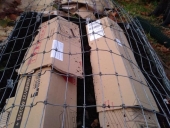First of all, hello! I've been listening to Paul for a couple months now and come here by way of listening to
Jack Spirko.
Now, to the reason I'm posting:
I'm listening to episode 87 about replacing irrigation with permaculture. I just got to the part where Paul is talking about why you should not transplant. I've decided that I'm going to experiment with my tomatoes this year. My problem is I don't really know when to plant. I usually start my seeds indoors around mid January and then plant them out around Mother's Day here outside Chicago. I'll do some of my tomatoes like this but I'll direct sow some as well and see what happens, but when to plant the seeds out?







